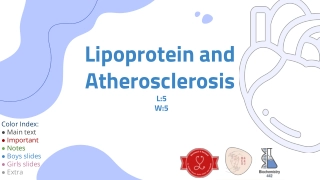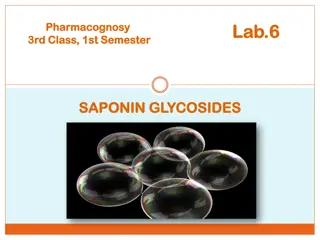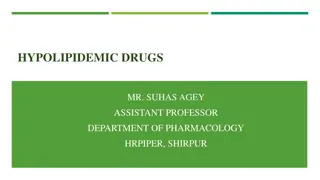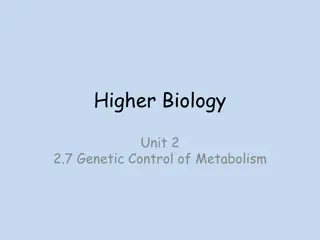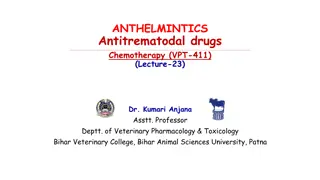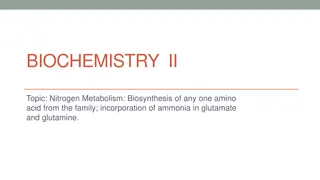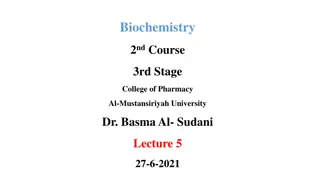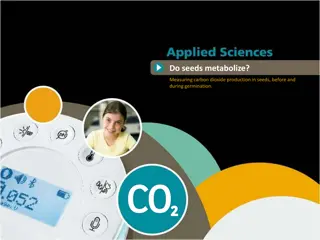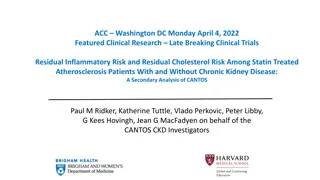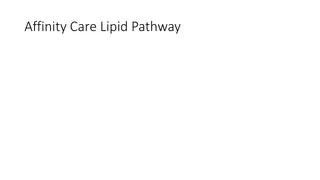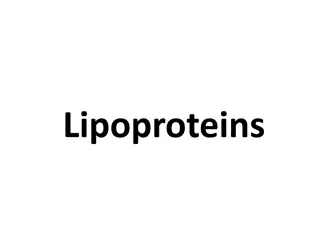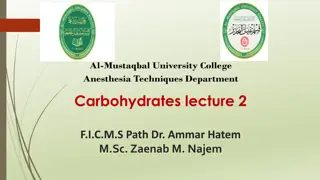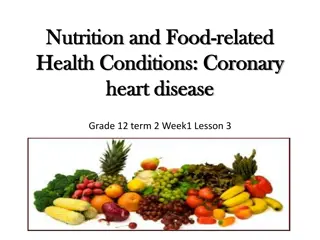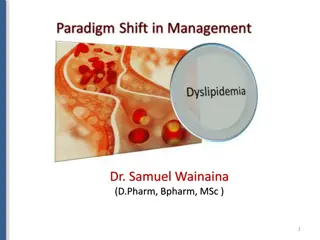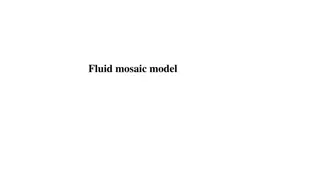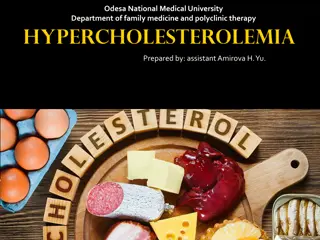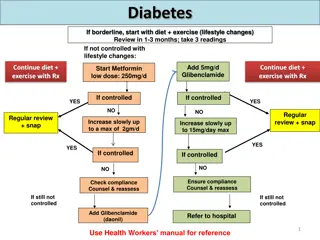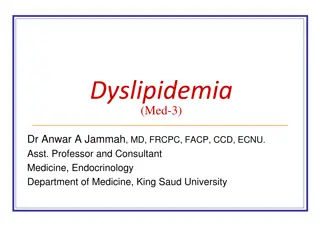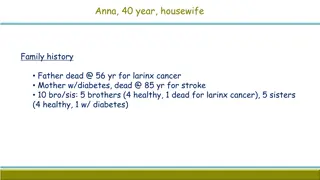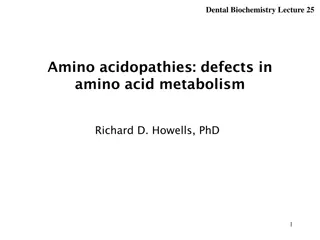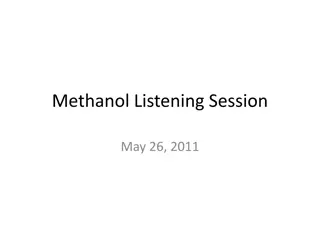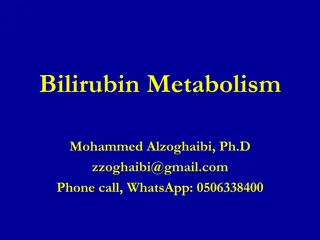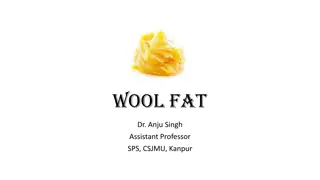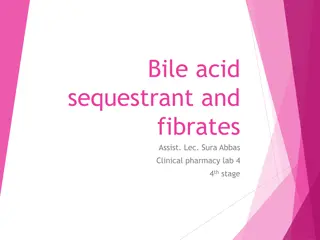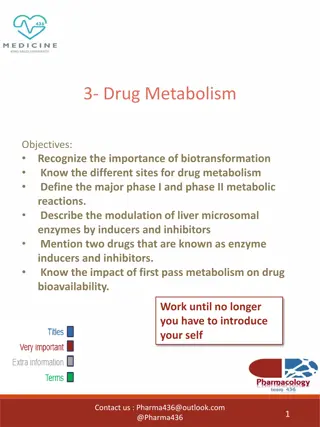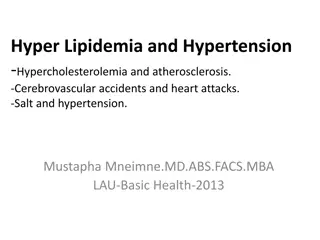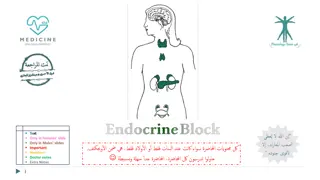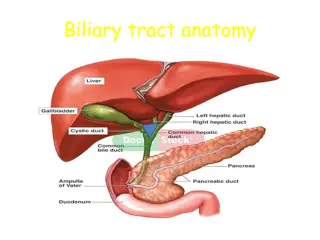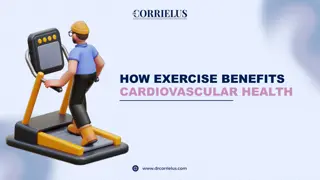Lipoprotein and Atherosclerosis
Understand the correlation between lipoprotein metabolism imbalance and the development of atherosclerosis. Learn about LDL and HDL cholesterol metabolism, receptor-mediated endocytosis, and the role of lipoprotein(a).
1 views • 19 slides
Inflammation and Cholesterol Predicting Cardiovascular Events
This study explores how inflammation and cholesterol levels predict cardiovascular events among 13,970 statin-intolerant patients in the CLEAR Outcomes trial. Findings suggest residual inflammatory risk may be a stronger predictor than residual cholesterol risk for future events. The research analyz
0 views • 17 slides
Understanding Pharmacokinetics in Clinical Pharmacology
Pharmacokinetics, as explained in a lecture by Oula Mohammed Sami, M.B.Ch.B/MSc in clinical pharmacology, delves into how the body processes drugs, contrasting with pharmacodynamics which focuses on drug actions. Key topics covered include properties influencing treatment outcomes, the significance
5 views • 45 slides
Understanding Saponin Glycosides in Pharmacognosy: Properties and Applications
Saponin glycosides, found in various plants, are compounds with diverse benefits ranging from cholesterol regulation to potential anticancer properties. They form colloidal solutions in water and are used in soap manufacturing due to their unique properties. Additionally, saponins have bitter taste,
6 views • 18 slides
HYPOLIPIDEMIC DRUGS
Major lipids like cholesterol and triglycerides play essential roles in the body, but their excess can lead to hyperlipidemia and related conditions. This overview covers the biosynthesis of cholesterol, triglycerides, and the transport of lipids in the bloodstream, discussing the importance of lipo
1 views • 30 slides
Treatment for High Cholesterol Healthy Life Bariatrics
Call us if you require medical help with surgery for high cholesterol. One of the most effective high cholesterol surgery centres in the US is Healthy Life Bariatrics. Please visit our website for further information if you require it.
0 views • 9 slides
Best treatment for Cholesterol Management in Mogador
NutrAdvantage provides the Best treatment for Cholesterol Management in Mogador. Their services include one-on-one consultations, detailed meal plans, and continuous education to help individuals achieve their health goals. For a holistic approach to nutrition, choose them. For any enquiries, guidan
0 views • 6 slides
Genetic Control of Metabolism in Microbes: Enhancing Traits for Biotechnology
Exploring the genetic control of metabolism in microbes, focusing on wild type organisms and the process of strain improvement through mutagenesis, selective breeding, and recombinant DNA techniques. The potential benefits and challenges of altering microbial genomes for biotechnological application
0 views • 27 slides
Understanding Cellular Respiration and Metabolism in Living Organisms
Cellular respiration is a vital process in all living cells, producing energy through chemical reactions. Metabolism, consisting of anabolism and catabolism, maintains growth and function. ATP plays a central role as energy currency in cells. Through stages like glycolysis and the Krebs cycle, cellu
0 views • 16 slides
Protein Digestion and Metabolism in Ruminants and Non-Ruminants
Digestion and metabolism of protein in both ruminants and non-ruminants involve enzymatic breakdown of proteins into polypeptides and amino acids in the stomach and intestines. Key enzymes such as pepsin, trypsin, and chymotrypsin play important roles in protein digestion. Gastric digestion in the s
1 views • 14 slides
Understanding Antitrematodal Drugs and Their Applications in Veterinary Medicine
Fascioliosis caused by F. hepatica is a common concern globally, impacting livestock health and economy. Antitrematodal drugs play a crucial role in combating parasitic infections like fascioliosis. One such drug, Carbon tetrachloride (CCl4), has been effective in treating F. hepatica due to its act
0 views • 33 slides
Understanding Nitrogen Metabolism: Amino Acid Biosynthesis and Ammonia Incorporation
Nitrogen metabolism is crucial in the biosynthesis of amino acids such as glutamate and glutamine, incorporating ammonia for various physiological processes. Ammonia is efficiently transported and stored using compounds like alanine and glutamate, playing a key role in the urea cycle. Glutamate, a v
0 views • 22 slides
Understanding Xenobiotic Metabolism for Biomedical Applications
Metabolism of xenobiotics, foreign chemicals like drugs, food additives, and pollutants, is crucial for pharmacology, toxicology, and disease management. Knowledge allows for beneficial applications such as antioxidant research, pollutant conversion, and drug biosynthesis using transgenic organisms.
0 views • 11 slides
Understanding Seed Metabolism: Measuring Carbon Dioxide Production Before and During Germination
Exploring the metabolic processes in seeds, this study aims to compare carbon dioxide production before and during germination. Students will hypothesize and verify using a carbon dioxide SensorLab sensor. Theoretical aspects of plant metabolism, including photosynthesis and cellular respiration, wi
1 views • 22 slides
Residual Inflammatory and Cholesterol Risks in Atherosclerosis Patients
In a secondary analysis of the CANTOS study, researchers evaluated the impact of residual inflammatory risk and residual cholesterol risk in a large cohort of atherosclerosis patients already receiving lipid-lowering therapy. Results showed the relative contributions of inflammation and cholesterol
0 views • 11 slides
Understanding Inborn Errors of Metabolism and Metabolic Disorders
Inborn Errors of Metabolism (IEM) are genetic disorders that disrupt metabolic pathways, leading to substrate accumulation or product deficiency. These disorders can be classified based on toxic accumulation, protein metabolism, carbohydrate intolerance, lysosomal storage issues, energy production d
0 views • 29 slides
Affinity Care Lipid Pathway Summary and Assessment
The Affinity Care Lipid Pathway outlines a systematic approach to assessing lipid/cholesterol blood results in individuals over 16 years old. It includes guidelines for managing cholesterol levels, assessing familial hypercholesterolemia, and determining appropriate medication options based on indiv
0 views • 5 slides
Decarboxylation Reaction and Biogenic Amines in Amino Acid Metabolism
Decarboxylation is a crucial reaction in amino acid metabolism where CO2 is removed to form biogenic amines, catalyzed by decarboxylase enzymes. Important biogenic amines include tyramine, tryptamine, and histamine, each impacting physiological functions like blood pressure regulation. Aromatic amin
0 views • 25 slides
Understanding Lipoproteins: Structures and Functions
Lipoproteins are compound lipids formed by the aggregation of neutral and amphipathic lipids with proteins (apoproteins). They serve as vehicles for transporting lipids through the bloodstream and lymphatic system, acquiring polarity due to their hydrophilic properties. These macromolecules are synt
0 views • 51 slides
Decoding Oxidative Decarboxylation and Krebs Cycle in Energy Metabolism
Explore the intricate processes of oxidative decarboxylation and the Krebs Cycle, essential pathways in cellular energy metabolism. Learn about the conversion of pyruvate to acetyl-CoA, regulatory mechanisms, clinical implications, and more. Discover the fates of pyruvate, allosteric regulation, and
6 views • 19 slides
Understanding Carbohydrate Metabolism and Diabetes Mellitus
Carbohydrates play a vital role in energy production through processes like glycolysis and gluconeogenesis. Glucose metabolism involves pathways like aerobic glycolysis and anaerobic lactate production. In diabetes mellitus, there is a disruption in carbohydrate metabolism leading to elevated blood
1 views • 14 slides
Understanding the Impact of Nutrition on Coronary Heart Disease
Explore the relationship between nutrition and coronary heart disease through images depicting blood cholesterol levels, food pyramids for both healthy individuals and those with high cholesterol, and methods to increase fiber in your diet. Understand how cholesterol buildup in arteries can lead to
0 views • 13 slides
Understanding Dyslipidemia and Lipoprotein Disorders
Plasma lipids are transported in complexes called lipoproteins. Dyslipidemia, characterized by elevated cholesterol, triglycerides, or low HDL cholesterol, is a major risk factor for cardiovascular diseases. Learn about lipid metabolism, dyslipidemia management approaches, and the role of pharmacy p
0 views • 32 slides
Understanding the Fluid Mosaic Model of Plasma Membrane Structure
The fluid mosaic model proposed by S.J. Singer and Garth L. Nicolson describes the structure of the plasma membrane as a fluid combination of phospholipids, cholesterol, proteins, and carbohydrates. This model explains how phospholipids form a stable barrier, the role of saturated and unsaturated fa
2 views • 6 slides
Understanding Cholesterol and Its Impact on Health
Cholesterol is essential for bodily functions but too much of it can lead to health issues. LDL cholesterol is known as "bad" cholesterol, while HDL cholesterol is considered "good". High cholesterol levels can increase the risk of heart disease and stroke. Managing cholesterol through diet, weight
0 views • 19 slides
Managing Diabetes, Hypertension, and Cholesterol: Overview of Treatment Guidelines
The guidelines outline step-by-step management strategies for borderline diabetes, hypertension, and cholesterol. For diabetes, lifestyle changes are first recommended, followed by medication if necessary. Hypertension management starts with diet and exercise, then progresses to medication if needed
0 views • 7 slides
Understanding Dyslipidemia and Lipid Transport in Atherosclerosis
Dyslipidemia is characterized by abnormal levels of lipids in the blood, leading to atherosclerosis. Lipid transport mechanisms play a crucial role in the formation and progression of atheromas in artery walls. Chylomicrons carry fats from the intestine to the liver, where they are processed into LD
0 views • 54 slides
Management of Cardiovascular Risk Factors in a Middle-Aged Housewife
Anna, a 40-year-old housewife with a family history of cancer and diabetes, presents with elevated blood glucose levels, high cholesterol, and hypertension. Initial management includes lifestyle changes, medication for blood pressure and cholesterol, and smoking cessation. Follow-up visits show impr
0 views • 15 slides
Overview of Amino Acidopathies in Dentistry: Defects in Amino Acid Metabolism
This lecture discusses the various amino acidopathies, including phenylketonuria, albinism, alkaptonuria, maple syrup urine disease, and homocystinuria. It covers the metabolic defects in amino acid metabolism, symptoms, causes, and treatment methods for these disorders. Emphasizing the importance o
0 views • 19 slides
Understanding Methanol Metabolism and Blood Levels
This content discusses the difference between background/endogenous and exogenous methanol, how metabolism of endogenous methanol affects exogenous metabolism, and the impact of exposure to different levels of methanol on blood concentrations. It highlights EPA PBPK models and assumptions regarding
0 views • 16 slides
Understanding Bilirubin Metabolism in Human Body
Bilirubin, a key pigment in bile, is derived from heme breakdown and plays a crucial role in the liver's detoxification process. This article explores the metabolism of bilirubin, its relationship with heme and globin, as well as its excretion steps involving enzymatic reactions and conjugation in h
0 views • 31 slides
Understanding Wool Fat: Properties, Sources, and Uses
Wool fat, also known as lanolin, is a pale yellow substance extracted from raw wool. It contains cholesterol, alcohols, and fatty acids and is insoluble in water. Prepared from sheep wool, wool fat is used in creams and ointments as an emollient base. Its purification involves processes like crackin
0 views • 8 slides
Understanding Bile Acid Sequestrants and Fibrates in Clinical Pharmacy
Bile acid sequestrants such as colestipol and cholestyramine act by binding bile acids, promoting hepatic conversion of cholesterol, and increasing LDL-receptor activity to clear LDL-cholesterol. They may interfere with fat-soluble vitamin absorption and have common side effects like constipation an
0 views • 27 slides
Understanding Drug Metabolism: Importance and Mechanisms
Drug metabolism is a crucial process in the body that transforms drugs into forms easily excreted, affecting their efficacy and toxicity. This involves different sites such as the liver, kidney, and plasma, with enzymes in cellular organelles like cytoplasm and mitochondria playing key roles. First-
0 views • 13 slides
Understanding Drug Metabolism and Excretion in Pharmacology
Drug metabolism involves the biotransformation of pharmaceutical substances in the body, primarily in the liver, to facilitate their elimination. This process helps convert drugs into less active forms for enhanced elimination through various reactions in Phase I and Phase II metabolism. Factors suc
0 views • 20 slides
Understanding Atherosclerosis: Causes, Symptoms, and Prevention
Arteriosclerosis and atherosclerosis are common cardiovascular conditions that involve the hardening and narrowing of arteries due to plaque buildup. Atherosclerosis specifically refers to the accumulation of fats and cholesterol in artery walls, leading to restricted blood flow and potential compli
0 views • 24 slides
Understanding Parathyroid Disorders - Calcium Metabolism and Hormonal Regulation
This presentation covers the functions of calcium, calcium metabolism, bone physiology, and hormonal regulation of calcium metabolism focusing on parathyroid hormone, calcitonin, and Vitamin D. It discusses hypo and hyperparathyroidism in detail, including clinical manifestations and treatment optio
0 views • 15 slides
Understanding Biliary Tract Anatomy and Interventional Procedures
Explore the anatomy of the biliary tract, including pathways of cholesterol metabolism in the liver and the composition of bile. Learn about conditions such as gallstones, polyps, and common bile duct abnormalities, as well as diagnostic procedures like ERCP. Discover indications for biliary stentin
0 views • 59 slides
Understanding Newer Antianginals and Cardiomyocyte Metabolism
Chronic angina is a condition marked by impaired quality of life and decreased life expectancy, primarily due to myocardial ischemia. It is characterized by symptoms like tightness, heaviness, and pressure sensation, often located retrosternally. The pathophysiology involves a mismatch between oxyge
0 views • 73 slides
How Exercise Benefits Cardiovascular Health
*Strengthens Heart Muscle: Regular exercise improves the heart's efficiency and increases its pumping capacity.\n*Improves Circulation: Enhances blood flow, promoting better oxygen delivery throughout the body.\n*Lowers Blood Pressure: Helps reduce hypertension by improving vascular function and pro
0 views • 3 slides
